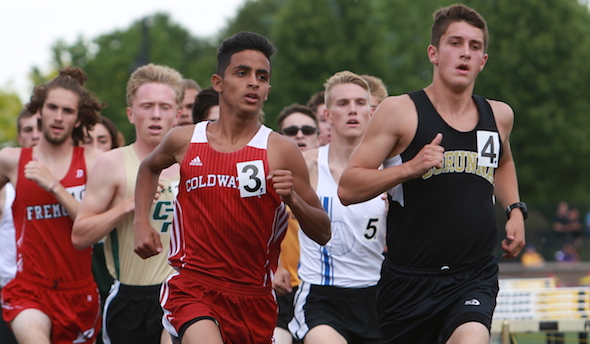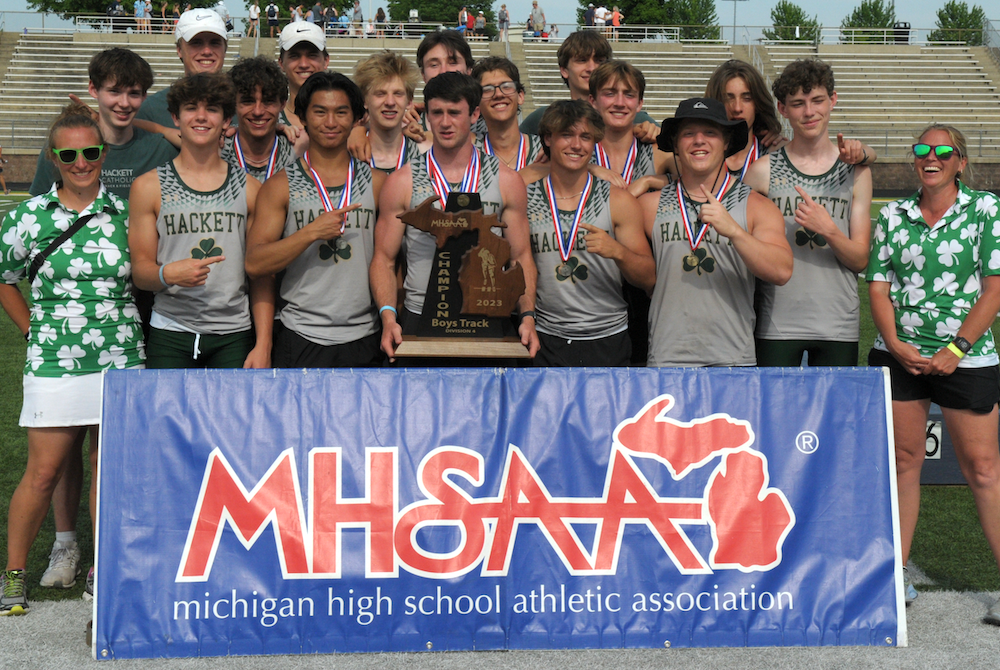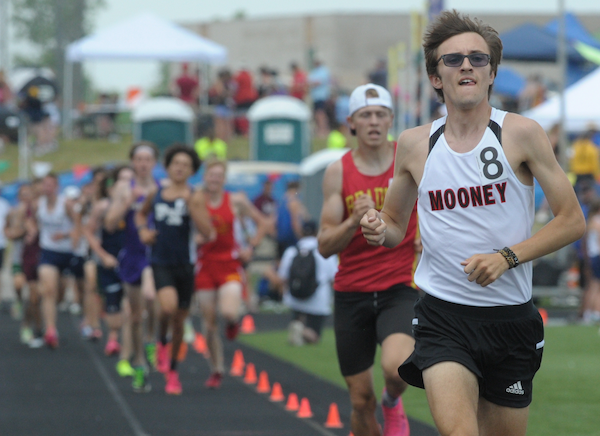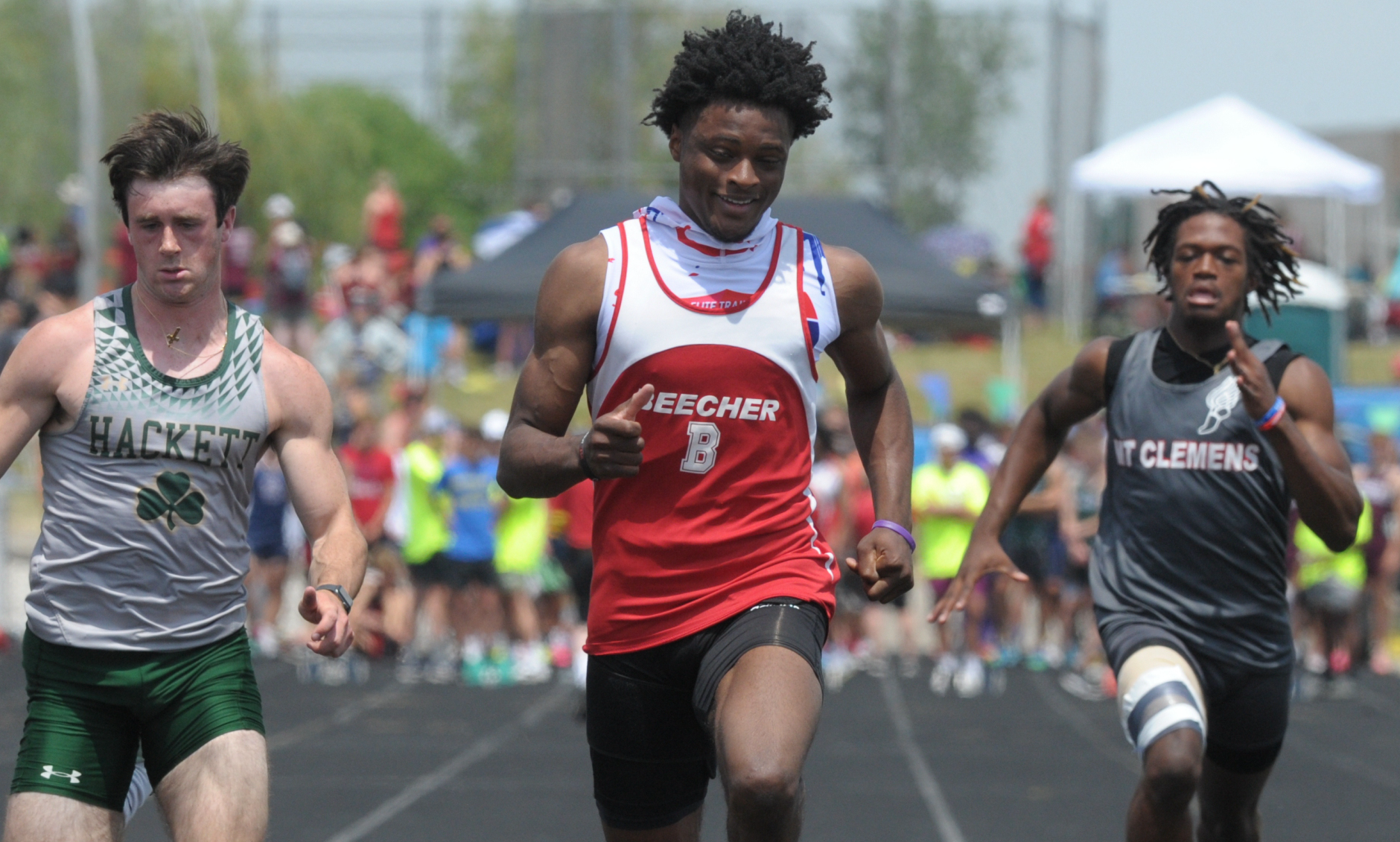
Corunna Star Recovers to Shine Again
By
Tom Markowski
Special for Second Half
June 3, 2017
ZEELAND – Noah Jacobs of Corunna is another in a long line of tremendous distance runners to come out of this state.
Among the names he’s chased include Olympian Dathan Ritzenhein of Rockford and Grant Fisher of Grand Blanc.
Jacobs, a senior headed for University of Wisconsin, was the two-time defending Lower Peninsula Division 2 Finals champion in the 3,200-meter run and last year he added the New Balance two-mile national championship.
This past fall Jacobs won the Division 2 cross country championship with a time of 15:28.00.
Unbeknownst to him, this year would be different. Challenges always present themselves, but Jacobs was shaken by what he had to face as he began to prepare for the 2017 track & field season.
In February, Jacobs was diagnosed with a stress reaction in his left tibia. A stress fracture is more severe. Fortunately for Jacobs, the injury stopped just short of a fracture.
Still, for five weeks he had to shelve his training and deal with the mental anguish of knowing it would be a long, painstaking road back to the MHSAA Finals, if indeed he could return.
A few weeks ago, Jacobs noticed his times were getting back to where they were a year ago. On Saturday, he fought off fierce competition and defended his LP Division 2 Finals titles in the 3,200 (9:11.63) and added a first-place finish in the 1,600 run with a time of 4:14.03 at Zeeland East to complete was has been a courageous comeback.
“Last season I was blessed with great health,” Jacobs said. “This year I was battling. I was losing races, to some good runners. I didn’t have that same kick. I had to break that mental barrier.
“(In February) I was a mental wreck. My teammates and my family kept me going.
“It was around Regional time, in early May, I was running in two or three quality meets. I kind of got my routine back. I got to use the race situations I used to use. The last two weeks have really been good. (My leg) is not perfect. People asked me how it is, and I have one word for them – ready. I’m ready.”
Jacobs had to fend off a couple runners coming into the second-to-last turn to win the 1,600.
“I took the lead with about 250 meters left,” he said. “I knew they wanted it. It could have been a tenth of a second, it could have been five seconds. I don’t know.”
His win in the 3,200 held more drama. He led with 600 meters to go before Shuaib Aljabaly of Coldwater put forth a burst of speed to pass Jacobs by two meters.
“I knew that I had to draft (early in the race),” Jacobs said. “I’ve raced (Aljabaly) before. I didn’t worry about him running. I just had to attack the last half. I had to push and push and push.
“I had a couple of coaches with 100 meters to go screaming at me. When he took the lead, I had to fight, fight. It’s happened before.”
Jacobs overtook Aljabaly with 50 meters left and won by 21 hundredths of a second.
Home cooking
One thing that can top winning an MHSAA Finals title is winning one at home.
Zeeland East won its first boys track & field team title with a score of 71 points. Coldwater placed second with 42.
East had clinched its 1,600 relay team took first as well.
Coach Ralph Neal, in his seventh season, said everything went right for his team.
“It was an amazing day,” he said. “I can look back at two years ago and what we were trying to build. I saw enough talent. I saw the field events. I saw the relays. We had all these pieces that came together. Nothing went wrong today. It’s what a coach dreams about.
“It is special winning it at home. (Athletic director) Tim Ritsema pulls his hair out to get this (event) going.”
Junior Brenden Knoll placed second in both the discus (176 feet, 7 inches) and shot put (55 feet) to earn his team 16 points. He said the formula to winning was basic.
“We put in the work, every day,” he said. “I just had my mind right. I put everything else aside. It feels real good. These are the reasons you work so hard.”
Getting serious pays off
John Adams III of Ferndale never qualified for the MHSAA Finals until this year. Last year he started running track for the first time, to stay in shape for football. That reasoning paid off as Adams, a 5-foot-10, 160-pound slot back and defensive back, will attend Olivet College in the fall with every intention of competing for a starting spot on the football team.
Fearless, Adams competed in the 100 dash, and he certainly wasn’t one of the favorites. That didn’t bother him. With a time of 10.94, Adams placed first in the 100.
“I won because I worked the hardest,” he said. “I didn’t take track seriously until this year. When I got beat in the (Oakland Activities Association) meet (May 11), that’s when it hit me. I finished third. It was hand-held time, and it was really close. I’m not sure anyone knew who won. I didn’t want that to happen again.”
Special days
Sunday is Noah Caudry’s 18th birthday. It’s likely he’ll remember the day before his 18th birthday better in the years to come.
Caudry of Lake Odessa Lakewood won the 110 and 300 hurdles, and helped his team place fifth in the 400 relay even though it didn’t compete in the fast heat.
His time in the 110 (14.05) was a personal best. He’s a three-time champion in that event.
“This is my specialty,” he said of the 110. “I was hoping for (the three consecutive titles). I was hoping to get in the 13s, but I’ll take a PR.”
Caudry is a remarkable person. He graduated with a 3.94 grade-point average and plans on entering optometry school after earning a degree in biology.
New event, new success
Junior Cameron Oleen was a half-miler since he began running track at Fruitport two years ago.
This season, it was suggested Oleen run the 400 dash. He’d never run it before but thought he’d give it a shot.
“I really like it,” he said. “It’s the most difficult race. I can pace myself in the 800. In the 400 you have to run as fast as you can all the way through it. You could pace yourself in the first 300 meters and then die in the last 100. You might as well run as fast as you can the first 300.”
It would be difficult to argue that point with Oleen. He won the 400 with a time of 49.21 seconds.
“It’s conditioning,” he said. “The 800 helps me train for the 400.”
Oleen also competes in cross country and basketball. He added that running cross country helps him maintain the proper conditioning for the other two sports.
PHOTO: Corunna's Noah Jacobs, far right, stays a step ahead of Coldwater's Shuaib Aljabaly during Saturday's 3,200 at Zeeland. (Photo by Janina Pollatz/RunMichigan.com.)

Thrower Claims Lone Individual Title to Lead Hackett to Team 3-Peat
By
Tom Lang
Special for MHSAA.com
June 3, 2023
Kalamazoo Hackett Catholic Prep just keeps winning and winning.
This time the Irish took home their fourth title in the last five Lower Peninsula Division 4 Track & Field Finals, on Saturday at Hudsonville.
Hackett’s only individual title was taken by discus winner Nathan Buchmann, a senior, who was fine knowing he was the shortest in stature among all the sizable competitors.
“In the offseason after football I worked out every day, working towards this goal,” he said after getting his medal. “I would say this takes 80 percent technique and 20 percent strength to throw the discus. So, length can help but if you have good technique and are really strong, that will play into it.
“I think we are very balanced throughout the meet today,” he said about teammates that scored points in finishes other than first place. “We have 13 guys here today, and we have people in a lot of the races. But I do not run; I have too short of legs to be a fast runner,” he said with a chuckle.
Buchmann had to work through a hip injury to compete this spring.
“I think the setbacks are what make you strong,” he said. “You can either give up through the setbacks or push forward and become better.”
 Coach Charissa Dean agreed.
Coach Charissa Dean agreed.
“The kids have big hearts,” she said after all the points were totaled and the Irish were on top once again, with 53. “They worked hard. They had a lot of potential when we started the season. And we had a lot of drive to put in the work, and we are happy the results came out the way they did.”
Reading was runner-up at 47 points, followed by Wyoming Potter’s House Christian with 42, then Fowler and Flint Beecher each with 37 points.
Senior Lezawe “Moses” Osterink, of Potter’s House Christian, placed second in 1,600 but took the 3,200 title as defending champ of both. He dominated the latter by lapping the field with a final lap kick that resembled more of a superhero speedster.
“Nobody really took it out that hard at the start,” he said. “There was a freshman (Marek Butkiewicz of Hackett) that tried to get the pace going quick, but me and Dakota (Dykhuis of Montabella) just kind of sat back and gradually pulled him through.
“We took it gradually, and I was just relying that I could kick.”
Kick did he ever. The trio were neck and neck the majority of the race in a grouping ahead of the pack.
“With 400 to go I just tried to go all out,” Osterink said. “I had a lot more left than I thought and I was pleased with the win. Not really the time, but that doesn’t matter, especially this hot out.”
The overall meet was in the low 90s/high 80s heat and searing sun all day. So, race officials allowed the unique opportunity for coaches to spray the runners with water and give them water bottles.
“It was very weird because I’ve never taken water to drink while I’m running, so I didn’t know how that would feel,” Osterink said. “And they were spraying us and hitting us in the face. It was kind of fun.”
Junior Tyler Lenn of Marine City Cardinal Mooney defeated Osterink at his own game in the 1,600.
“I’m feeling great,” Lenn said after grabbing the medal. “I said to a newspaper after one of my races (during the season) I was right where I wanted to be. This has been a long rebuilding process for me since an injury back in the fall, and I set a pretty high goal the day the injury happened. I was telling myself I needed to fulfill what I said I would do at the beginning of last cross country season. And that is what I did today.”
Lenn suffered an ankle sprain from a misstep that turned worse because he kept running through the season on it.
“Coming back from that was pretty tough, but I wouldn’t have it any other way,” he said.  “Perseverance; I said from the beginning what I was going to do. I kept my eye on that target, and no matter the circumstances life threw at me, that I was going to make it happen and I am a man of my word.”
“Perseverance; I said from the beginning what I was going to do. I kept my eye on that target, and no matter the circumstances life threw at me, that I was going to make it happen and I am a man of my word.”
Jaylin Townsend, a senior from Flint Beecher, dominated the short races. He won the 100 dash (10.67) and 200 dash at 22 seconds flat. It was his third 100 win at a Finals.
“I put in a lot of work; I had to three-peat,” he said after the 100. “There’s a lot of great competition here, so I knew I had to come out and run my best.”
Concord in the 400 (43.72), Buckley in the 800 (1:30.76) and 1,600 (3:29.13) and Potter’s House in the 3,200 (8:14.18) were relay champs Saturday. Reading’s Tayshawn Bester won the 110 hurdles (15.13), and Athens’ Landen Bennett won the 300 (39.85). Caseville’s Nathan Feltner won the 400 (50.76), and Vestaburg’s Owen Patton claimed the 800 (1:55.11).
Fruitport Calvary Christian’s Bradley Richards won the high jump (6-10), and Peck’s Alex Affer won the long jump (23-4). McBain Northern Michigan Christian’s Isaac Bowden was first in pole vault (13-0), and Brown City’s Kyle Affer won shot put (49-2).
PHOTOS (Top) Kalamazoo Hackett Catholic Prep celebrates its third-straight LPD4 title Saturday. (Middle) Cardinal Mooney's Tyler Lenn, far right, sets the pace in the 1,600. (Below) Flint Beecher's Jaylin Townsend, middle, crosses the finish first for one of his two sprint championships. (Photos by Ken Swart/RunMichigan.com.)

